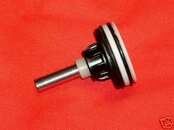Texfrazer
Guest
I once flew halfway around the world to stay on a live aboard dive boat in Truk. My regulator started to leak out of the ambient pressure holes. With a pair of Channel Lock pliers, a vice and a piece of tape (to put over the piston) I was able to swap out the discrepant o-ring. Sure, my regulator still has those scars from 20 years ago, but I still use it. Sure, I could have rented a piece of junk from the boat, but because I had faith in my ability to repair it, why would I have bothered?
Come to the dark side.
Couv
What Couv is not telling is that he repaired the reg during a dive, while buddy breathing, using an urchin spine as an o-ring pick.
I thought that I'd read that he'd used a sting-ray's barb, not an urchin spine, but that just goes to show you can't trust everything the internet tells you.





